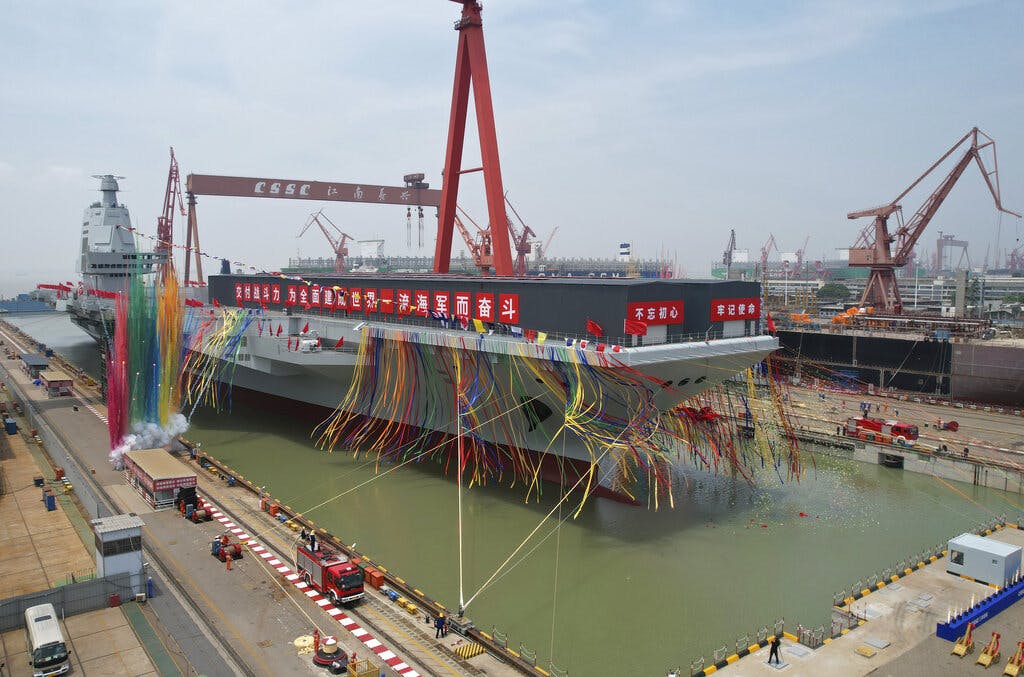Seas Emerge as Ultimate Arbiters of Global Power, as Communist China Expands Its Fleet and America Retreats
The People’s Republic’s maritime GDP is now $1.4 trillion, nearly 8 percent of its total output.

Recent news of a 6 percent expansion of Communist China’s marine gross domestic product is noteworthy. China’s marine GDP is now some $1.4 trillion, roughly 7.9 percent of its total economic output. Among other matters, this growth has bolstered Beijing’s coast guard in size and gall, prompting such aggressive actions as those seen against the Philippines. It has expanded its illicit fishing activities and territorial maneuvers.
With the world otherwise distracted, Beijing recently annexed part of the Gulf of Tonkin. The figure is also significant for how widely it has been reported in China. It signals progress, genuine or not, towards President Xi’s vision of China as a “truly great maritime power.” In 2021, America’s marine GDP was some 1.9 percent of its national output — a fact known to few and likely cared about by fewer. It might be time for this to change.
America was once a great maritime power. Presidents from Theodore Roosevelt to Ronald Reagan recognized the role of sea power for national strength and built the Navy into an unrivaled force. They understood the historical precedent, captured in Alfred Thayer Mahan’s 1890 work, “The Influence of Sea Power Upon History,” of the dominance of sea powers across the ages. Under President Reagan, the Navy had nearly 600 battle force ships.
Such strength allowed us to win wars, project power, and secure freedom of navigation. Those lessons appear to have since been forgotten. Today, the Navy counts 291 battle force ships and 231 combatants. Many, like United States Ship Boxer, are in long-term maintenance, waiting to be rearmed or upgraded, or needing crew. Under normal circumstances, the Boxer would be the flagship of the Boxer Amphibious Ready Group.
President Biden’s 2025 budget calls for six ships while retiring 19. The shipbuilding industry is in dire straits, with our ability to produce surface warships and submarines outmatched by China by a factor of 200. Mr. Xi and China’s communists have also learned some historical truths about sea power. During the Century of Humiliation, naval losses to the Royal and Japanese fleets compelled China to relinquish territories.
Victories on land during the Sino-French War were reversed by France’s marine nationale. In the West these events are rarely mentioned. Yet they are etched into the CCP’s collective memory and inform many of its foreign policies. Sea power is, after all, a conscious political decision. For Beijing, too, such power extends beyond naval and shipping capabilities to include the wider marine ecosystem, as evidenced by its GDP metric.
China’s marine GDP encompasses three “ocean industries.” The first broadly includes fishing activities. With more than 10,000 capable vessels, China’s fishing fleet is the world’s largest. Yet many of these vessels operate illegally, targeting endangered species or encroaching upon the sovereign waters of other nations including, increasingly, in South America. For Beijing, “fishing” is often a pretext for attempted territorial control.
This first ocean industry constitutes 4.7 percent of China’s total marine GDP. The largest share, 59.5 percent, comes from the third industry, “marine tourism and recreation.” Under Beijing’s strategy of military-civil fusion, this industry often overlaps with the second, “shipping and transportation.” Cruise ships — long dismissed as military assets with the arrival of amphibious attack ships in the 1950s — indeed make for superb assault platforms.
With today’s technology, too, they require few modifications to excel. China’s first homegrown cruise liner, the Adora Magic City, sailed in December. Equipped for 5,246 passengers and 20 314-person lifeboats, the ship could deploy more than 6,000 troops in a single wave if Beijing chose to convert it for military use. And why not? It’s done so with all its civilian vessels. These dual-use ships frequent China-owned dual-use ports worldwide.
There, they often link with Russian and Iranian vessels to engage in other “ocean industries” covered by China’s marine GDP — offshore oil and gas, construction, mining, and “sea area and island use.” Indeed, the quantitative aspects of Beijing’s growing sea power obscure the broader challenge at hand: an axis of non-democratic states intent on shifting the maritime balance of power. Recently, Iran declared itself a “prominent naval power.”
Its proxies, the Houthis, are sinking ships and killing sailors in the Red Sea. Russia is laying claim to international waters in the Arctic Ocean. The seas have again emerged as the ultimate arbiters of global power. If America hopes to retain such power, it must swiftly, and again, prioritize the maritime domain. At the least, we might ask what our marine GDP is, too.

